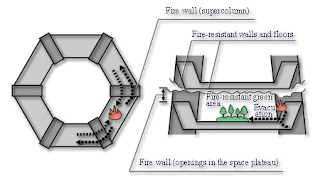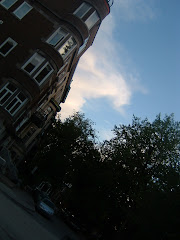Happiness is a persistent state of mind in which people are deeply satisfied with themselves and their surroundings. In this state, people find themselves in a total equilibrium, feeling both of themselves and their surroundings (and even the entire world) are pleasurable and under control.
The most important factor of happiness is stability. If the satisfaction lasts only for a short period of time, that state is not called happiness but euphoria. Euphoria is often accompanied by the fear of losing it. It creates negative feelings as byproducts, that is, anxiety, suspicion, or excessive aggressiveness such as greediness or arrogance.
Happiness is also a self-contented feeling which expects nothing or little if any from surroundings. People in this state try to share what they have with others. Or rather they render others happy without any intention to do it.
Monday, April 23, 2007
Topic for Presentation

I am struggling to find an appropreate topic. As I like the culture of '60 and '70, I hoped to do some research on some novels or authors of that era. But I was told that just tracing the life of authors or their novels is not enough for a research. Then how about looking up about Montreal in that era?
I have to leave here soon, but I do not know much about this city. Before leaving Montreal, I would like to have deeper knowledge on this city. This year, 2007, is 40th anniversary of Montreal Expo. I will try to find good topic regarding Expo.
(Expo '67 poster, taken from Wikipedia)
Thursday, April 12, 2007
Colleges Need A Reply. May I See Your Notes? (NY Times)
In the admitted-student season, highschool seniors who applied colleges or universities are courted like celebrities by the colleges that accepted them and that are worrying that students may go to other places. Some students send their application to so many colleges in the fear of being rejected that they get accepted even by the one they've never seen. To narrow down the choice, the best way is to visit the colleges. But not everyone has the time or money to travel around different campuses.
Internet can be a good tool to retrieve information you need. Forget about general ranking because now is the time to make a decision. Focus on the things that you will care about when you get there. Some websites like "Collegeconfidential.com" offers hundreds of anonymous reports about everything (atmosphere, bathroom, friendliness of college staff). Or "Collegeprowler.com" gives you ratings of colleges in nontraditional unique categories such as Greek life and night life. But do not rely on too much on one opinion. It is good to communicate with people who had visited there, and take their comment with a grain of salt.
I was attracted to this article as I just visited the college I am planning to go in the previous break. The real college and the impression I got from neat photos on website had a big difference. (In fact, I was slightly disappointed with the smallness of the town.) But the hostel I stayed was not so bad as I expected from comments and the lowest ratings on a website. It is really difficult to judge something using indirect information because everyone has his/her own filter, and especially everyone has different needs. From my experience, I think that the best way to make a choice is to experience it first-handedly even though there is still a possibility to make a false decision.
Internet can be a good tool to retrieve information you need. Forget about general ranking because now is the time to make a decision. Focus on the things that you will care about when you get there. Some websites like "Collegeconfidential.com" offers hundreds of anonymous reports about everything (atmosphere, bathroom, friendliness of college staff). Or "Collegeprowler.com" gives you ratings of colleges in nontraditional unique categories such as Greek life and night life. But do not rely on too much on one opinion. It is good to communicate with people who had visited there, and take their comment with a grain of salt.
I was attracted to this article as I just visited the college I am planning to go in the previous break. The real college and the impression I got from neat photos on website had a big difference. (In fact, I was slightly disappointed with the smallness of the town.) But the hostel I stayed was not so bad as I expected from comments and the lowest ratings on a website. It is really difficult to judge something using indirect information because everyone has his/her own filter, and especially everyone has different needs. From my experience, I think that the best way to make a choice is to experience it first-handedly even though there is still a possibility to make a false decision.
Superskyscraper
Since modern skyscrapers appeared in the middle of 19th century, North America had had a monopoly on this power. In fact, in the year of 1980, all of the top 20 tallest buildings were in the U.S or in Canada. But the tide has completely shifted. Now 8 out of the top 10 are in Asia--- the current highest building is Taipei 101 (Taiwan, 509m), followed by the Petronas Tower (Malaysia, 452m), the Sears Tower (U.S., 442m) and the Jin Mao Tower (China, 421m). Asian countries such as Malaysia and China has two big reasons which drive them to build high towers;  economic and population boom.
economic and population boom.
Despite Japan's sluggish economy and little prospect of population growth, Tokyo has now more than 10 plans of skyscrapers over 500m. Sky City 1000 is among those blueprints. If this plan is carried out, it is considered to help alleviating chronic congestions and compensating lack of green areas. According to the planner, Takenaka Corporation, this 1,000m tall high-rise is "a fusion of architecture, transportation, communications, and energy" which offers "intensive functions and harmony with the natural environment". This vertical city is comprised of 14 concave dish- shaped
"Space Plateaus" stacked one upon the other. Residences, offices, commercial facilities, schools, theaters and so forth are organically located in these spaces, and they can accommodate 3,500 full-time residents and 10,000 workers. Aside from triple-decker elevators which connects those plateaus, trains circuit in each plateau facilitating the travel within the city. Openings between the plateaus let the air and natural light come in, and they also serve as the vents for toxic smokes once a fire occurs. Green areas can prevent the fire from spreading.
(Graphics: taken from website of Takenaka Corporation)
 economic and population boom.
economic and population boom.Despite Japan's sluggish economy and little prospect of population growth, Tokyo has now more than 10 plans of skyscrapers over 500m. Sky City 1000 is among those blueprints. If this plan is carried out, it is considered to help alleviating chronic congestions and compensating lack of green areas. According to the planner, Takenaka Corporation, this 1,000m tall high-rise is "a fusion of architecture, transportation, communications, and energy" which offers "intensive functions and harmony with the natural environment". This vertical city is comprised of 14 concave dish- shaped
"Space Plateaus" stacked one upon the other. Residences, offices, commercial facilities, schools, theaters and so forth are organically located in these spaces, and they can accommodate 3,500 full-time residents and 10,000 workers. Aside from triple-decker elevators which connects those plateaus, trains circuit in each plateau facilitating the travel within the city. Openings between the plateaus let the air and natural light come in, and they also serve as the vents for toxic smokes once a fire occurs. Green areas can prevent the fire from spreading.
(Graphics: taken from website of Takenaka Corporation)
Superskyscraper (sequel)
I learned that many state-of-the-art engineering devices are used in superskyscrapers to cope with wind and earthquakes. But personally, in the terms of security, I do not place so much trust in technology. Simulation is simulation, after all. No one had ever imagined that an airplane would crash into the World Trade Center. No one predicted that asbestos would be so harmful to human body that it can cause deadly diseases to builders, residents and even tourists. In fact, according to Hans Netten, the editor of "The High-Rise Pages" (his website about skyscrapers), the collapse of high-rise towers due to natural disasters is occurring more often than we think. The sky may be the limit, "but who wants to live in a building 1 mile high?" Mir M. Ali, an architecture professor at the University of Illinois and author of "Art of the Skyscraper" says. I agree with him. He points out that the view from such a superskyscraper is not so good when you are surrounded by clouds. He also points to that a more realistic height would be around 150 stories and 2,000 feet.
"A skyscraper is a boast in glass and steel." is an aphorism by Mason Cooley (1927-2002, American aphorist). Super high-rises look like mutated freaks sprout in the middle of the city rather than buildings which shelter people. If I recognize the skyscrapers as a solution for anything, it is not for the accommodation space but for the green zones that is in critical shortage in urban areas. I might get a feel of relief in a construction which combines greens and reminds us of Mother Nature rather than a box made by concrete and steel. In this sense, the realization of Sky City 1000 is favorable for me if it really is a fusion of urban life and natural environment as the planner maintains.
Subscribe to:
Comments (Atom)

